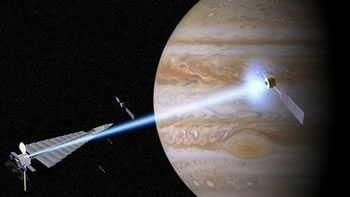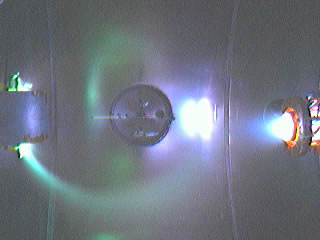Science Fiction
Dictionary
A B C D E F G H I J K L M N O P Q R S T U V W X Y Z
MagBeam Propulsion - To Mars And Back In 90 Days

Magnetized-beam plasma propulsion, or magbeam propulsion, could cut the time required for long journeys around the solar system from years to weeks.

(From Mag-beam propulsion)
The MagBeam propulsion system is being developed at the University of Washington; earth and space sciences professor Robert Winglee is leading the project.
"We're trying to get to Mars and back in 90 days," Winglee said. "Our philosophy is that, if it's going to take two-and-a-half years, the chances of a successful mission are pretty low."People usually think of a spacecraft as a ship with both payload and power source. The MagBeam system separates these two logical units; the power source stays in one place (for example, in permanent orbit around the Earth). Spacecraft are pushed to other parts of the solar system.
Advantages of MagBeam Propulsion
MagBeam propulsion offers significant advantages over conventional rockets:- One power source could be used to power multiple craft (serially, not at the same time).
- The power source could use solar energy, resulting in additional cost savings.
- Plasma propellants are accelerated to speeds an order of magnitude greater than those achieved by chemical rocket propellants, resulting in higher spacecraft velocities - at least 26,000 miles per hour.
- A round trip to Mars would take 2 1/2 years using current technology. If the trip time could be shortened, many other difficulties (like the quantity of consumables and the psychological effects on the astronauts) could be greatly eased.
How MagBeam Propulsion Works
The system requires a power source at each end of a journey; one to accelerate the spacecraft at the start and another at the destination, to decelerate it. The spacecraft simply coasts during the journey from planet to planet. Once MagBeam power sources are placed at destinations around the solar system, the system can be operated using solar power alone.MagBeam depends upon a highly collimated plasma beam. The high power helicon (HPH) under development at the University of Washington is a state-of-the-art electrodeless plasma thruster, which allows high power levels to be generated over long periods of time with little erosion of the system. The plasma is generated by high power radio frequency waves; as a result, HPH is substantially smaller than other plasma thrusters.

(From High Power Helicon)
The spacecraft will need to have a deflector system to accept the energy from the HPH. This can be achieved by plasma magnet systems; plasma effects are used to make an initially large magnetic deflector. The system is self-focussing. Click to see a video showing deflection and self-focussing.

(From MagBeam Deflector System)
So when can we expect a MagBeam test mission? According to Dr. Winglee, within 5 years if funding remains consistent. Residents of Seattle can attend the NASA Advanced Concepts Institute meeting early this week to learn more.
The idea of separating the spacecraft and its payload from its power source was first explored in science fiction in the excellent 1974 novel Mote in God's Eye, by Larry Niven and Jerry Pournelle. In the book, a battery of laser cannon were used to accelerate a small ship with a light sail to a significant fraction of the speed of light. The original idea for a laser-based propulsion system is credited to Robert L. Forward and dates from 1961. You may also enjoy this article on Solar Windsurfing; it provides an interesting precursor to the idea of laser cannon.
See the original article New propulsion concept could make 90-day Mars round trip possible.
Scroll down for more stories in the same category. (Story submitted 10/16/2004)
Follow this kind of news @Technovelgy.| Email | RSS | Blog It | Stumble | del.icio.us | Digg | Reddit |
Would
you like to contribute a story tip?
It's easy:
Get the URL of the story, and the related sf author, and add
it here.
Comment/Join discussion ( 29 )
Related News Stories - (" Space Tech ")
Will Space Stations Have Large Interior Spaces Again?
'They filed clumsily into the battleroom, like children in a swimming pool for the first time, clinging to the handholds along the side.' - Orson Scott Card, 1985.
Reflect Orbital Offers 'Sunlight on Demand' And Light Pollution
'I don't have to tell you about the seven two-mile-diameter orbital mirrors...'
Chrysalis Generation Ship to Alpha Centauri
'This was their world, their planet —
this swift-traveling, yet seemingly moveless vessel.' - Nat Schachner, 1934
The First Space Warship For Space Force
'Each of the electrical ships carried about twenty men...' - Garrett P. Serviss, 1898.
Technovelgy (that's tech-novel-gee!) is devoted to the creative science inventions and ideas of sf authors. Look for the Invention Category that interests you, the Glossary, the Invention Timeline, or see what's New.
Science Fiction
Timeline
1600-1899
1900-1939
1940's 1950's
1960's 1970's
1980's 1990's
2000's 2010's
Current News
Jetson ONE Air Races Begin, Can Air Polo Be Far Behind?
'If you're one of those rarities who haven't attended a rocket-polo "carnage", let me tell you it's a colorful affair.'
Will Space Stations Have Large Interior Spaces Again?
'They filed clumsily into the battleroom, like children in a swimming pool for the first time, clinging to the handholds along the side.'
Mornine Sales Robot
'Robot-salesmen were everywhere, gesturing...'
Bipedal Robot Floats Gently While Walking
'a walking balloon proceeded with long strides of its aluminum legs...'
Musk Idea Of Cars Talking To Each Other Predicted 70 Years Ago
'My cars talk to one another.'
Elegant Bivouac Shelter Produces Water And Electricity
'There was nowhere on the planet where science and technology could not provide one with a comfortable home...'
X-Control Janus-1 A Suitcase Aircraft
'You will notice that it... fits the suitcase nicely.'
'AI Assistants' Are Actually Less Reliable For News
'Most men updated their PIP on New Year's Day...'
YES!! Remote Teleoperated Robots predicted by Technovelgy!
'...a misshapen, many-tentacled thing about twice the size of a man.'
Will Robots Ever Fold Landry?
Where have you gone, Mrs. Robinson?
Will AIs Give Better Results If You're Rude To Them?
'I said, "Listen up, motherf*cker.'
Cybertruck Robotic Arm F10 Drone Launch!
Drone away!
Black Fungus Blocks Radiation
'You were surrounded by Astrophage most of the time'
Liuzhi Process Now In Use In China
'He was in a high-ceilinged windowless cell with walls of glittering white porcelain.'
Reflect Orbital Offers 'Sunlight on Demand' And Light Pollution
'I don't have to tell you about the seven two-mile-diameter orbital mirrors...'
Will Robots Become Family Caregivers?
'The robant and the tiny old woman entered the control room slowly...'
